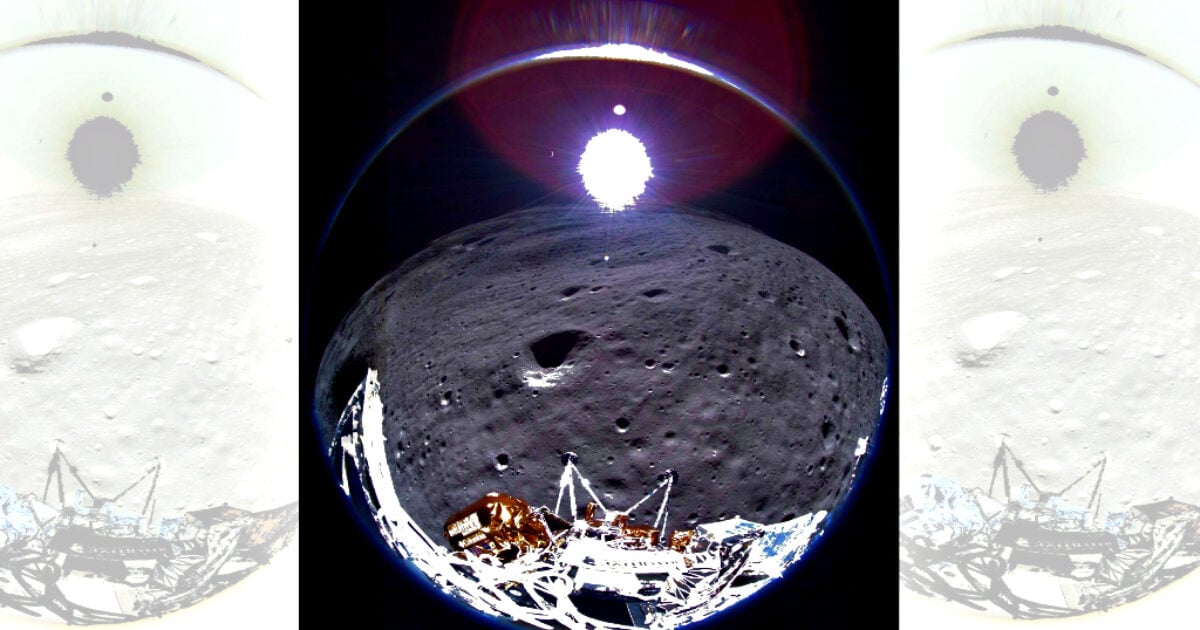Odysseus has gone to sleep. After its heroic mission that returned America to the moon after half a century, the Nova-C moon lander has powered down, and it’s widely expected to have ended its work.
Spacecraft have limited lifespans, even when everything goes according to plan, which was hardly the case in this odyssey, as the lander ‘faced more than its share of difficulties’.
‘Odie’ has now gone dark on the surface of the moon, but before it did, it sent back a goodbye image ‘that summarizes the joys and heartbreak of space exploration’.
Forbes reported:
“Odysseus — operated by Texas-based Intuitive Machines — made a triumphant touchdown on February 22, marking the first U.S. moon landing in over 50 years. It broke a dry streak that reaches back to NASA’s 1972 Apollo 17 mission. The landing process did not go smoothly. Odysseus ended up in a tipped-over position, which caused communications problems. It also meant the solar panels were not able to fully power the lander through its planned mission. Intuitive Machines believes at least one of the lander’s legs broke.
The lander’s farewell image shows part of the machine’s body and its feet with the pockmarked and gray surface of the moon below. There’s lens flare worthy of a J.J. Abrams blockbuster. The real treat is almost hidden. A tiny crescent Earth is visible in the background against the darkness. It’s a little glimpse of home from a robotic explorer far away from where it was built.
Intuitive Machines received the image on February 29. ‘Before its power was depleted, Odysseus completed a fitting farewell transmission’, the company tweeted. ‘Received today, this image from February 22nd showcases the crescent Earth in the backdrop, a subtle reminder of humanity’s presence in the universe’.”
The Nova-C was the first landing for NASA’s Commercial Lunar Payload Services initiative (CLPS), in which the space agency partners with private companies on moon missions.
It’s part of NASA’s preparation efforts for sending humans back to the moon through the Artemis program.
NASA’s blog stated:
“During transit, all powered NASA payloads operated and received data. During descent and landing, guidance and navigation data was collected that will help improve landing precision in the future, and all three payloads that were designed to operate on the surface have received data.
The first images from the lunar surface are now available and showcase the orientation of the lander along with a view of the South Pole region on the Moon. Intuitive Machines believes the two actions captured in one of their images enabled Odysseus to gently lean into the lunar surface, preserving the ability to return scientific data. After successfully transmitting the image to Earth, there is additional insight into Odysseus’ position on the lunar surface.”
NASA plans to send astronauts to the moon as early as 2026.
Meanwhile, NASA studies transit and landing technologies, and learns what’s happening in the moon’s south polar region that could have water-ice resources needed to establish a human presence on the moon, and also prepare for missions that go deeper into the solar system.
There is a chance the lander could get back on if it can get enough power in the future.
Mission control downloaded as much data as possible and commanded the lander to ‘phone home if and when he wakes up when the sun rises again’.
Before its power was depleted, Odysseus completed a fitting farewell transmission. Received today, this image from February 22nd showcases the crescent Earth in the backdrop, a subtle reminder of humanity’s presence in the universe.
Goodnight, Odie. We hope to hear from you… pic.twitter.com/RwOWsH1TSz
— Intuitive Machines (@Int_Machines) February 29, 2024
Read more:




